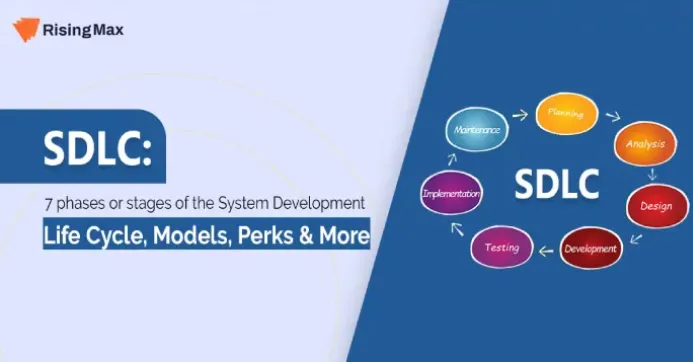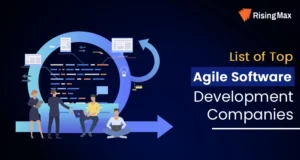A long-standing notion in the wide world of IT, a system development life cycle, or SDLC, is an iterative process that incorporates numerous activities that constitute the development of a structured information technology system.

This word has been around for many decades and stems from a time when organizations were much more centralized. Still, as IT as a field and IT services as a market have evolved, SDLC has become an integral aspect of how custom software development company develop software solutions.
This post offers a thorough examination of the system development life cycle. You will understand what an SDLC is, the 7 stages of the system development life cycle, and why it is vital by reading it.
Let’s get this game started.
What is SDLC?
A system development life cycle (SDLC) is a systematic project management model that lays out the steps involved in developing an IT system, from conception to completion.
The goal of a system development life cycle is to allow for the efficient production of a high-quality solution that meets or exceeds a client’s expectations at all 7 stages of the system development life cycle while staying within budget and time constraints.
7 Phases Of System Development Life Cycle
A system development life cycle is a conceptual model that delineates the stages involved in developing and implementing a system. Each stage is important in the development process and differs from the others in terms of complexity, assets required, and intended functionalities.
A system development life cycle is divided into, seven phases of sdlc: Let’s take a look at each of them individually now.
1. System Development Life Cycle: Planning
The most important stage of the SDLC process is planning. It entails determining and defining the project scope in order to develop a complete action plan for the project, as well as identifying the issues that the solution will address.
This phase lays out what will happen during the project’s life cycle and decides whether or not it will succeed. At this point, the team structure, time frame, budget, security, and other critical issues should all be considered.
2. System Development Life Cycle: Analysis
Gathering all of the specific details required for a new system, as well as defining the first prototype concepts, is part of the analysis step.
In the 7 stages of system development life cycle, this stage empowers the developers to have the option to:
- Define any needs for the prototype system.
- Alternatives to current prototypes should be considered.
- Conduct research and analysis to discover end-user requirements.
A software requirement specification, or SRS document, is frequently created by developers. This document contains all of the software, hardware, and network specifications for the system they intend to create. When working in the same location as other development teams, will prevent them from overdrawing cash or resources.
3. System Development Life Cycle: Design
The design stage is required before moving on to the primary developer stage.
Developers will begin by outlining the overall application’s characteristics, as well as individual aspects such as:
- Network and network requirements
- Databases
- System interfaces
- User interfaces
Further, it is also defined as two steps.
HLD – High-Level Design – Architects and senior developers create the architecture of the software product to be built.
LLD stands for Low-Level Design. Senior developers are in charge of this. It explains how each and every aspect of the product, as well as each component, should function. Only the design, not the code, will be seen here.
This phase produces a High-Level Document and a Low-Level Document, which are used as inputs in the next phase of 7 stages of the system development life cycle.
4. System Development Life Cycle: Development
The development stage is when programmers write code and build the application based on the design papers and specifications that were created earlier.
In these seven phases of the systems development life cycle the product program code is written in accordance with the design document’s specifications. All of the preliminary planning and outlining should, in principle, make the actual development step pretty simple.
Developers will follow the organization’s coding rules and use various tools such as compilers, debuggers, and interpreters.
C++, PHP, and other programming languages are examples of common programming languages. Based on the project specs and requirements, developers will select the appropriate programming code.
5. System Development Life Cycle: Testing And Integration
Building software isn’t the end of the process.
It must now be thoroughly tested to ensure that there are no issues and that the end-user experience is not harmed in any way. Developers will go over their software with a fine-tooth comb during the testing stage, identifying any flaws or defects that need to be recorded, corrected, and retested.
It’s critical that the program meets the quality requirements outlined in the SRS document.C++, PHP, and other programming languages are examples of common programming languages. Based on the project specs and requirements, developers will select the appropriate programming code.
6. System Development Life Cycle: Implementation And Release
The general design for the app will come together after testing. Developer efforts will integrate different modules or designs into the core source code, frequently by employing training environments to find additional faults or defects of the seven steps in the planning phase of the system development life cycle.
The information system will finally be built and incorporated into its environment. After clearing this stage, the program is considered market-ready and may be distributed to any end user.
7. System Development Life Cycle: Maintenance
The SDLC does not end when the software is released to the public. Developers must now enter maintenance mode and begin practicing any procedures necessary to address issues identified by end users.
Developers are also in charge of implementing any updates that the software may require after it has been deployed.
This can include resolving new issues that arise as a result of user reports or dealing with leftover bugs that were not able to be corrected before launch. In comparison to smaller systems, larger systems may require more maintenance phases.
Align the current state of IT with your business strategy by hiring the most trustworthy Blockchain Development Company
System Development Life Cycle Models
After knowing the seven steps in the planning phase of the system development life cycle, we’ll also look at two of the most common SDLC models, as well as one sub-model – Waterfall, Agile, and data system development life cycle, to name a few. Each has advantages and disadvantages that must be considered in order to make an informed selection.
Waterfall Model System Development Life Cycle
The Waterfall model, one of the earliest SDLC models, is a linear, sequential technique popular in IT product development that emphasizes the importance of continually progressing from one stage to the next. Each stage must be completed in its entirety before moving on to the next; once a stage is done, it cannot be revisited.
Pros:
- Simple to comprehend and implement
- Timelines and milestones are well-defined.
- Documentation that is clear
- Good coding practices are reinforced.
- Provides a strong foundation.
Cons:
- Unsuitable for tasks that are complicated or object-oriented.
- Extremely inflexible when it comes to scope modifications
- It’s difficult to accurately predict time and budget.
- Only later in the cycle does a working product emerge.
Agile System Development Life Cycle Methodology
Agile has supplanted the Waterfall system development life cycle technique as a main driving factor behind software development in the great majority of enterprises across industries since it is a dynamic and interactive framework.
This method results in several release cycles, during which each iteration is tested, bugs are resolved, and input from stakeholders is gathered. It entails iterative development, constant improvement, and adaptability in the face of change.
Pros:
- Allows for rapid development and testing.
- Issues are swiftly identified and corrected.
- Changes or improvements are accommodated.
- Face-to-face communication and ongoing feedback are essential.
- Design and documentation are given less importance.
- Scalability
Cons:
- Employees must have past expertise in developing agile software.
- Design and documentation are given less importance (this may be a disadvantage for some)
- A project manager with agile software development experience is sought.
- At the start of development, there was no idea how the final product would look.
Benefits of System Development Life Cycle
The System Development Life Cycle is a conceptual paradigm for both software and non-digital systems. Knowing the benefits and drawbacks of a system development life cycle will aid you in making the best decision for your system.
7 stages of the System Development Life Cycle offer a lot of benefits to development teams who use it properly.
Goals that are well-defined
Developers have a clear understanding of the objectives they must achieve and the deliverables they must complete within a certain time frame, reducing the risk of wasting time and money.
Prior to installation, proper testing is required.
Checks and balances are built into SDLC models to ensure that all software is thoroughly tested before being integrated into larger source code.
The stages of Development are Clearly Defined
Developers are unable to progress to the following age unless the previous one has been completed and approved by management.
Flexibility of Members
Team members can depart and be replaced rather smoothly because SDLCs include well-structured papers covering project goals and processes.
It Is Possible To Achieve Perfection
All levels of the SDLC are designed to feed back into one another. SDLC models can thus assist projects in iterating and improving themselves until they are essentially ideal.
No single team member may make or break the project.
Again, because SDLCs rely heavily on documentation and guidelines, it’s a team effort, and losing even a key person won’t put the project’s deadline in jeopardy.
Importance Of Systems Development Life Cycle
The difficulty of designing a system from the ground up is reduced by using a system development life cycle. It is critical to follow the stages of the System Development Life Cycle in place since it aids in the transformation of a project’s concept into a fully functional and operational structure.
SDLC assists with process development, change management, user experience, and policies in addition to technical aspects of system development. An SDLC also provides for planning ahead of time, determining expenses and staffing decisions, defining goals, measuring performance, and validating points at each stage of the cycle to improve the final product’s quality.
Another significant benefit of using a system development life cycle is the ability to plan ahead of time and assess the organized phases and goals of a software system project.
Goal-oriented processes don’t follow a one-size-fits-all methodology; instead, they adapt and respond to user needs, which is why having a well-defined plan to determine costs and staffing decisions, provide goals and deliverable, measure performance, and apply validation points at each phase of the life cycle to improve quality is critical.

Conclusion: 7 Stages of System development life Cycle
It’s critical to follow the seven phases of the System Development Life Cycle whenever you’re working on a new product.
Before starting development on a new system, it’s critical to understand how an SDLC will fulfil the overall requirements and help achieve the best result. Choosing the correct SDLC can assist you in swiftly and successfully developing the system you require. As a result, IT consulting companies in New York are able to work in a regulated and well-organized setting, following a planned approach to the development of new solutions.
If you have any remaining questions about this topic, please contact our team and we will walk you through the most important details so you can get the most out of it.











